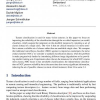Free Online Productivity Tools
i2Speak
i2Symbol
i2OCR
iTex2Img
iWeb2Print
iWeb2Shot
i2Type
iPdf2Split
iPdf2Merge
i2Bopomofo
i2Arabic
i2Style
i2Image
i2PDF
iLatex2Rtf
Sci2ools
BMVC
2010
2010
Robust Texture Recognition Using Credal Classifiers
Texture classification is used for many vision systems; in this paper we focus on improving the reliability of the classification through the so-called imprecise (or credal) classifiers, which suspend the judgment on the doubtful instances by returning a set of classes instead of a single class. Our view is that on critical instances it is more sensible to return a reliable set of classes rather than an unreliable single class. We compare the traditional naive Bayes classifier (NBC) against its imprecise counterpart, the naive credal classifier (NCC); we consider a standard classification dataset, when the problem is made progressively harder by introducing different image degradations or by providing smaller training sets. Experiments show that on the instances for which NCC returns more classes, NBC issues in fact unreliable classifications; the indeterminate classifications of NCC preserve reliability but at the same time also convey significant information, reducing the set of pos...
| Added | 10 Feb 2011 |
| Updated | 10 Feb 2011 |
| Type | Journal |
| Year | 2010 |
| Where | BMVC |
| Authors | Giorgio Corani, Alessandro Giusti, Davide Migliore, Jürgen Schmidhuber |
Comments (0)

